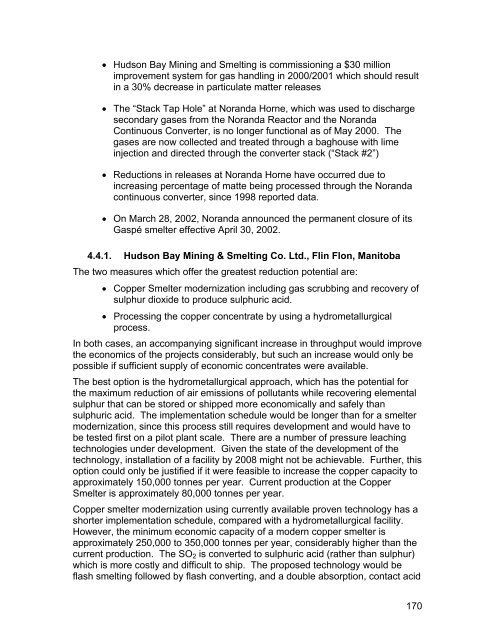(MERAF) for the Base Metals Smelting Sector - CCME
(MERAF) for the Base Metals Smelting Sector - CCME
(MERAF) for the Base Metals Smelting Sector - CCME
You also want an ePaper? Increase the reach of your titles
YUMPU automatically turns print PDFs into web optimized ePapers that Google loves.
• Hudson Bay Mining and <strong>Smelting</strong> is commissioning a $30 million<br />
improvement system <strong>for</strong> gas handling in 2000/2001 which should result<br />
in a 30% decrease in particulate matter releases<br />
• The “Stack Tap Hole” at Noranda Horne, which was used to discharge<br />
secondary gases from <strong>the</strong> Noranda Reactor and <strong>the</strong> Noranda<br />
Continuous Converter, is no longer functional as of May 2000. The<br />
gases are now collected and treated through a baghouse with lime<br />
injection and directed through <strong>the</strong> converter stack (“Stack #2”)<br />
• Reductions in releases at Noranda Horne have occurred due to<br />
increasing percentage of matte being processed through <strong>the</strong> Noranda<br />
continuous converter, since 1998 reported data.<br />
• On March 28, 2002, Noranda announced <strong>the</strong> permanent closure of its<br />
Gaspé smelter effective April 30, 2002.<br />
4.4.1. Hudson Bay Mining & <strong>Smelting</strong> Co. Ltd., Flin Flon, Manitoba<br />
The two measures which offer <strong>the</strong> greatest reduction potential are:<br />
• Copper Smelter modernization including gas scrubbing and recovery of<br />
sulphur dioxide to produce sulphuric acid.<br />
• Processing <strong>the</strong> copper concentrate by using a hydrometallurgical<br />
process.<br />
In both cases, an accompanying significant increase in throughput would improve<br />
<strong>the</strong> economics of <strong>the</strong> projects considerably, but such an increase would only be<br />
possible if sufficient supply of economic concentrates were available.<br />
The best option is <strong>the</strong> hydrometallurgical approach, which has <strong>the</strong> potential <strong>for</strong><br />
<strong>the</strong> maximum reduction of air emissions of pollutants while recovering elemental<br />
sulphur that can be stored or shipped more economically and safely than<br />
sulphuric acid. The implementation schedule would be longer than <strong>for</strong> a smelter<br />
modernization, since this process still requires development and would have to<br />
be tested first on a pilot plant scale. There are a number of pressure leaching<br />
technologies under development. Given <strong>the</strong> state of <strong>the</strong> development of <strong>the</strong><br />
technology, installation of a facility by 2008 might not be achievable. Fur<strong>the</strong>r, this<br />
option could only be justified if it were feasible to increase <strong>the</strong> copper capacity to<br />
approximately 150,000 tonnes per year. Current production at <strong>the</strong> Copper<br />
Smelter is approximately 80,000 tonnes per year.<br />
Copper smelter modernization using currently available proven technology has a<br />
shorter implementation schedule, compared with a hydrometallurgical facility.<br />
However, <strong>the</strong> minimum economic capacity of a modern copper smelter is<br />
approximately 250,000 to 350,000 tonnes per year, considerably higher than <strong>the</strong><br />
current production. The SO 2 is converted to sulphuric acid (ra<strong>the</strong>r than sulphur)<br />
which is more costly and difficult to ship. The proposed technology would be<br />
flash smelting followed by flash converting, and a double absorption, contact acid<br />
170
















